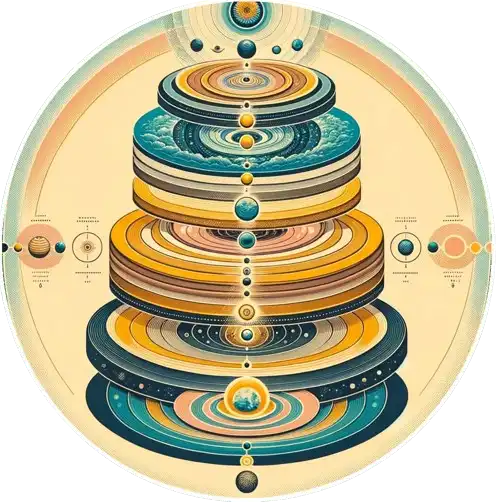1. Understanding the Lokas
Hindu cosmology typically divides the universe into three main realms: the upper, middle, and lower worlds, each comprising several lokas.
1. Upper Worlds (Svarga Lokas):
- Satyaloka: The abode of Brahma, the creator, where souls that have attained the highest form of enlightenment reside.
- Tapoloka: Inhabited by ascetics and sages who have transcended desires through severe penances.
- Janaloka: Home to the sons of Brahma, known as the Sanaka brothers, who are forever pure and celibate.
- Maharloka: A realm for those who have attained great heights in spiritual practices and knowledge.
- Svarloka or Svargaloka (Heaven): The heavenly realm of the gods, led by Indra, filled with pleasures unattainable on Earth.
- Bhuvarloka: The intermediate space between heaven and earth, inhabited by semi-divine beings and sages.
2. Middle World (Bhu Loka):
- Bhuloka: The Earth, considered the realm of human beings, where the duality of karma (action) and dharma (duty/righteousness) plays out.
3. Lower Worlds (Patala Lokas):
- Atala, Vitala, Sutala, Talatala, Mahatala, Rasatala, and Patala: These seven realms form the netherworld, primarily the domain of demons, nagas (serpents), and other beings. Each loka has its ruler and unique characteristics, often described as places of great beauty but also of different forms of existence, contrary to the divine harmony of the upper worlds.
2. FAQs
Q1: What is the purpose of the lokas in Hindu cosmology? The lokas serve multiple purposes, including the explanation of the universe's structure, the consequences of karmic actions, and the various stages of spiritual evolution.
Q2: Can humans travel to these lokas? According to Hindu scriptures, travel between lokas is possible through spiritual advancement, meditation, and after death, based on one's karma.
Q3: How do the lokas relate to the concept of reincarnation? The lokas are closely tied to the cycle of samsara (reincarnation), with souls moving between them based on their karma until achieving moksha (liberation) and escaping the cycle.
Q4: Are these lokas physical places or spiritual dimensions? The lokas are often interpreted as spiritual dimensions rather than physical places, representing various states of consciousness and existence.
3. Online Resources
For those interested in exploring the concept of lokas further, the following resources can be invaluable:
- The Vedas and Upanishads: Ancient texts available in digital libraries such as the Internet Sacred Text Archive provide detailed descriptions of the lokas.
- Online Courses: Platforms like Coursera and Udemy offer courses on Hindu philosophy and cosmology, including the study of lokas.
- Blogs and Articles: Many spiritual websites and blogs delve into the lokas' significance, offering interpretations and insights into their meaning in modern life.
4. Conclusion
The lokas of Hindu cosmology present a fascinating and complex view of the universe, embodying the philosophical depths of Hindu thought. They illustrate the vastness of cosmic order, the moral consequences of actions, and the potential for spiritual evolution. Understanding the lokas encourages a deeper appreciation of the interconnectedness of all existence and the journey of the soul towards enlightenment.
As we navigate our lives in the Bhuloka, the teachings on the lokas offer valuable lessons on dharma, karma, and the pursuit of moksha. They remind us of the impermanent nature of worldly pleasures and the eternal pursuit of spiritual wisdom. In exploring the lokas, we embark on a journey not just through the cosmos, but also into the depths of our own consciousness, unlocking the mysteries of existence and the path to ultimate liberation.

